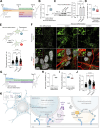Protein Kinase C promotes peroxisome biogenesis and peroxisome-endoplasmic reticulum interaction
- PMID: 40689797
- PMCID: PMC12278821
- DOI: 10.1083/jcb.202505040
Protein Kinase C promotes peroxisome biogenesis and peroxisome-endoplasmic reticulum interaction
Abstract
Peroxisomes carry out a diverse set of metabolic functions, including oxidation of very long-chain fatty acids, degradation of D-amino acids and hydrogen peroxide, and bile acid production. Many of these functions are upregulated on demand; therefore, cells control peroxisome abundance, and by extension peroxisome function, in response to environmental and developmental cues. The mechanisms upregulating peroxisomes in mammalian cells have remained unclear. Here, we identify a signaling regulatory network that coordinates cellular demand for peroxisomes and peroxisome abundance by regulating peroxisome proliferation and interaction with ER. We show that PKC promotes peroxisome PEX11b-dependent formation. PKC activation leads to an increase in peroxisome-ER contact site formation through inactivation of GSK3β. We show that removal of VAPA and VAPB impairs peroxisome biogenesis and PKC regulation. During neuronal differentiation, active PKC leads to a significant increase in peroxisome formation. We propose that peroxisomal regulation by transient PKC activation enables fine-tuned responses to the need for peroxisomal activity.
© 2025 Borisyuk et al.
Conflict of interest statement
Disclosures: The authors declare no competing interests exist.
Figures











Similar articles
-
The p97 ATPase and its adaptor UBXD8 maintain peroxisome pools by preventing pexophagy.J Cell Biol. 2025 Sep 1;224(9):e202409024. doi: 10.1083/jcb.202409024. Epub 2025 Jul 29. J Cell Biol. 2025. PMID: 40728716
-
Pex3 promotes formation of peroxisome-peroxisome and peroxisome-lipid droplet contact sites.Sci Rep. 2025 Jul 8;15(1):24480. doi: 10.1038/s41598-025-07934-2. Sci Rep. 2025. PMID: 40628847 Free PMC article.
-
Adenovirus Modulates Toll-Like Receptor 4 Signaling by Reprogramming ORP1L-VAP Protein Contacts for Cholesterol Transport from Endosomes to the Endoplasmic Reticulum.J Virol. 2017 Feb 28;91(6):e01904-16. doi: 10.1128/JVI.01904-16. Print 2017 Mar 15. J Virol. 2017. PMID: 28077646 Free PMC article.
-
Peroxisome dynamics and inter-organelle interactions in neuronal health and disease.Front Mol Neurosci. 2025 Jun 20;18:1603632. doi: 10.3389/fnmol.2025.1603632. eCollection 2025. Front Mol Neurosci. 2025. PMID: 40621503 Free PMC article. Review.
-
Peroxisomal Alterations in Prostate Cancer: Metabolic Shifts and Clinical Relevance.Cancers (Basel). 2025 Jul 4;17(13):2243. doi: 10.3390/cancers17132243. Cancers (Basel). 2025. PMID: 40647540 Free PMC article. Review.
References
-
- Alexander, A., Kim J., Cai S.-L., Kastan M., Sahin M., and Walker C.. 2008. mTOR signaling is regulated by TSC2 at the peroxisome. Cancer Res. 68:2729.
MeSH terms
Substances
Grants and funding
LinkOut - more resources
Full Text Sources
